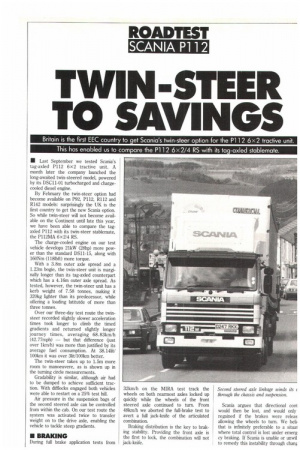TWIN STEER TO SAVINGS
Page 45

If you've noticed an error in this article please click here to report it so we can fix it.
• Last September we tested Scania's tag-axled P112 6 x 2 tractive unit. A month later the company launched the long-awaited twin-steered model, powered by its DSC11-01 turbocharged and chargecooled diesel engine.
By February the twin-steer option had become available on P92, P112, R112 and R142 models: surprisingly the UK is the first country to get the new Scalia option. So while twin-steer will not become available on the Continent until late this year, we have been able to compare the tagaxled P112 with its twin-steer stablemate, the P112MA 6x2/4 RS.
The charge-cooled engine on our test vehicle develops 21kW (28hp) more power than the standard DS11-15, along with 160Nm (118Ibft) more torque.
With a 3.8m outer axle spread and a 1.23m bogie, the twin-steer unit is marginally longer than its tag-axled counterpart which has a 4.16m outer axle spread. As tested, however, the twin-steer unit has a kerb weight of 7.58 tonnes, making it 320kg lighter than its predecessor, while offering a loading latitutde of more than three tonnes.
Over our three-day test route the twinsteer recorded slightly slower acceleration times took longer to climb the timed gradients and returned slightly longer journey times, averaging 68.83km/h (42.77mph) — but that difference (just over llun/h) was more than justified by its average fuel consumption. At 38.14Iit/ 100krn it was over 3lit/100km better.
The twin-steer takes up to 1.5m more room to manoeuvere, as is shown up in the turning circle measurements.
Gradability is similar, although air had to be dumped to achieve sufficient traction. With diffiocks engaged both vehicles were able to restart on a 25% test bilL Air pressure in the suspension bags of the second steered axle can be controlled from within the cab. On our test route the system was activated twice to transfer weight on to the drive axle, enabling the vehicle to tackle steep gradients.
• BRAKING
During full brake application tests from 32km/h on the MIRA test track the wheels on both rearmost axles locked up quickly while the wheels of the front steered axle continued to turn. From 481un/h we aborted the full-brake test to avert a full jack-knife of the articulated combination.
Braking distribution is the key to braking stability. Providing the front axle is the first to lock, the combination will not jack-knife. Scania argues that directional cont would then be lost, and would only regained if the brakes were releas allowing the wheels to turn. We bell' that is infinitely preferable to a situat where total control is lost under emerg cy braking. If Scania is unable or unwil to remedy this instability through chang




















































































